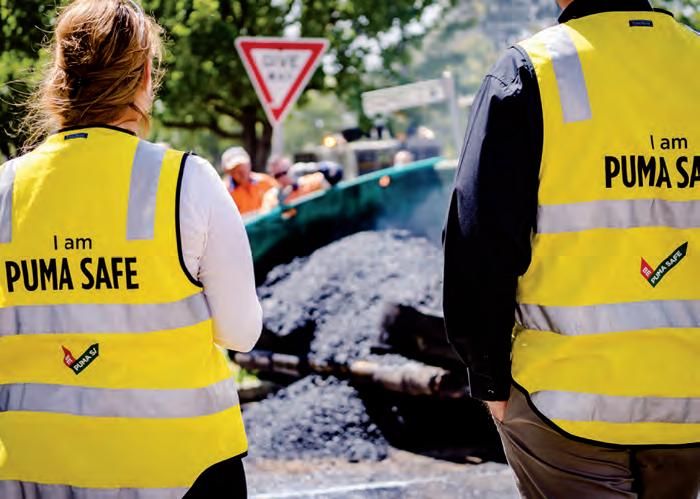
5 minute read
Crumb rubber bitumen
CONQUERING A CRUMB RUBBER CHALLENGE
PUMA BITUMEN’S NEW CRUMB RUBBER MODIFIED BINDER IS SET TO BECOME A STANDOUT IN ITS SUITE OF HIGH PERFORMANCE ROAD BINDERS. MEETING AUSTROADS BINDER SPECIFICATIONS, IT HAS BECOME ONE OF THE FIRST CRUMB RUBBER BINDERS THAT REQUIRES NO CHANGES TO A STANDARD ASPHALT MIX DESIGN.
In 2019, the Victorian Department of Transport, Tyre Stewardship Australia and the Australian Road Research Board set the road construction industry a challenge.
As part of a plan to accelerate crumb rubber asphalt, industry was asked to create a high-performance mix equivalent to their current stone mastic asphalt with polymer modified binder.
Consequently, the Department of Transport and Tyre Stewardship Australia announced tenders in 2020 for up to six variations of high-performance asphalt. These asphalt mixes will make up a largescale trial of crumb rubber asphalt on an arterial road, taking place in Melbourne.
Results from the trial will be used to inform Victorian crumb rubber specifications for arterial roads. By giving authorities and end-users the confidence to incorporate crumb rubber in high-traffic applications, its usage will continue to grow and subsequently reduce the environmental impact of end-of-life tyres.
It has now been four months since the trial was announced, and the road construction industry has been prepping its rubber asphalt mixes for implementation.
Partly inspired by the Department of Transport’s challenge, major bituminous product supplier Puma Bitumen developed OLEXOCRUMB, a crumb rubber binder that will be used in the trial.
“Going further for better-performing roads” is not just a tag line, but an ethos deeply embedded in the character of the Puma Bitumen team. This ethos is shown in their latest creation, OLEXOCRUMB,
which conforms to the Austroads polymer modified binder specification and can, therefore, be used in existing contracts.
The binder incorporates 10 per cent recycled tyre rubber and can be incorporated into asphalt mix designs as a direct substitute for conventional polymer modified binders.
As the rubber provides elastic properties to the binder, the mix represents a highvalue application of the waste material, with every tonne produced repurposing the equivalent of 15 passenger tyres.
Erik Denneman, Puma Bitumen Technical Manager – Middle East and AsiaPacific, says the initiative to develop OLEXOCRUMB came from the challenge society and governments are facing in finding beneficial uses for waste tyres.
With countries like India clamping down on used tyre exports, the export of whole baled tyres is increasingly becoming unsustainable. Over the past five years, Australia generated 56 million equivalent passenger units annually, with used tyres that are not recovered often sent to landfill or stockpiled.
Dr. Denneman says that OLEXOCRUMB will help reduce Australia’s tyre burden by demonstrating performance outcomes that can compete with existing options.
“The performance of OLEXOCRUMB is equivalent in all aspects of performance to our existing polymer modified binders,” Dr. Denneman says.
OLEXOCRUMB is a hybrid binder, containing both tyre-derived rubber and styrene-butadiene-styrene rubber. The key benefit to this particular crumb rubber binder is that the asphalt mix design does not have
Puma’s OLEXOCRUMB range will make up a large-scale trial of crumb rubber asphalt on an arterial road.

to be altered to accommodate the binder.
“Normally when you put rubber into bitumen, it leaves residual rubber parts and you then have to change the mix design to make space for it in the asphalt. With OLEXOCRUMB, there is negligible residual rubber, so you don’t have to change the mix design,” Dr. Denneman says.
“Changing a mix design is a timeconsuming and costly exercise and if you have to change it to allow for residual rubber, that has a significant impact.”
Puma Bitumen, in partnership with Boral Asphalt, has already completed a trial with a Victorian local council, where a section of OLEXOCRUMB asphalt was laid on 2 March 2020.
“The binder complied with all requirements of the Austroads specification and that was our main goal. The contractor was also able to place the asphalt successfully and it behaved just like a normal binder would on the rollers and paver, which is what we expected,” Dr. Denneman says.
“This binder can be used immediately and on a large scale, so potentially we could see a lot more rubber used in more asphalt, very quickly.”
Dr. Denneman says Puma’s production method for OLEXOCRUMB resulted in negligible crumb rubber residue, meaning it can be used in the same way as conventional bituminous binders. He says the support of industry-leading manufacturing equipment allowed the speciality binder to become a reality.
“We have very efficient, high-powered production facilities which were designed for our premium polymer modified binders in our OLEXOBIT range that have proved highly successful in the past,” he says.
“That same equipment, which is unique to Puma, is also uniquely suited to make this type of crumb rubber binder.”
Added to the environmental benefits is the use of a warm mix additive, which allows the asphalt to be produced at lower temperatures.
“We decided to produce this product with a warm mix as for every 12 degrees of temperature reduced in the production of asphalt, the level of emissions is halved,” Dr. Denneman says.
The asphalt will be produced at temperatures below 165 degrees Celsius in line with the Australian Asphalt Pavement Association’s recommendation for crumb rubber.
Puma Bitumen performed laboratory asphalt and binder testing to ensure the binder met all requirements in the Austroads specifications.
Puma’s OLEXOCRUMB binder was laid as part of the VicRoads demonstration overnight on 18 March in partnership with Boral (weather permitting).
The mix laid in the demonstration trial was a stone mastic asphalt mix using OLEXOCRUMB as the binder.
The Australian Road Research Board monitored emissions on the night the asphalt was laid and will monitor the pavement’s condition over two years.
Dr. Denneman says emissions monitoring is one of the most important parts of the trial, as it will be key to demonstrating that the asphalt mixes being laid do not expose workers to harmful emissions.
He adds that Puma Bitumen expects that the results of the trial will confirm with work done elsewhere. Dr. Denneman says that in line with that work, it will show that if placed at warm mix temperatures, the amount of emissions from crumb rubber modified asphalt are on par with conventional asphalt.
Puma Bitumen expects to be able to offer this binder as part of its product offering in Victoria, NSW and Queensland later this year. The company could also potentially look at offering binders with crumb rubber as a standard, in place of traditional binders, to the industry in the future.
“We are fully expecting to be laying more of this bitumen very soon, in states across the country,” Dr. Denneman says.
“I believe the industry should be focusing on products that give us improved performance, not just reducing waste to landfill, and OLEXOCRUMB undoubtedly meets both these criteria.”










